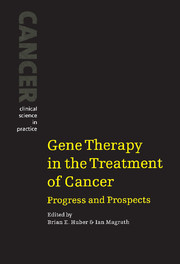Book contents
- Frontmatter
- Contents
- Contributors
- Preface
- 1 Introduction: gene therapy approaches to cancer
- 2 Principles of transformation-directed cancer therapy
- 3 Vectors for cancer gene therapy
- 4 Genetically engineering drug sensitivity and drug resistance for the treatment of cancer
- 5 Oncogene inactivation and replacement strategies for cancer
- 6 Genetically modified tumor cells as tumor vaccines
- 7 Genetically modified lymphocytes and hematopoietic stem cells as therapeutic vehicles
- 8 Pharmacologic effects of oligonucleotides and some clinical applications
- 9 Current status of gene marking and gene therapy in oncology clinical trials
- 10 Safety testing for gene therapy products
- Index
3 - Vectors for cancer gene therapy
Published online by Cambridge University Press: 01 April 2010
- Frontmatter
- Contents
- Contributors
- Preface
- 1 Introduction: gene therapy approaches to cancer
- 2 Principles of transformation-directed cancer therapy
- 3 Vectors for cancer gene therapy
- 4 Genetically engineering drug sensitivity and drug resistance for the treatment of cancer
- 5 Oncogene inactivation and replacement strategies for cancer
- 6 Genetically modified tumor cells as tumor vaccines
- 7 Genetically modified lymphocytes and hematopoietic stem cells as therapeutic vehicles
- 8 Pharmacologic effects of oligonucleotides and some clinical applications
- 9 Current status of gene marking and gene therapy in oncology clinical trials
- 10 Safety testing for gene therapy products
- Index
Summary
In recent years there has been a dramatic increase in developing gene therapy approaches for the treatment of cancer. In principle, gene therapy involves the transfer of foreign genetic material into a patient in an effort to treat a particular disease (Mulligan, 1993). The two events which have permitted the formulation of the concept of cancer gene therapy are the new understanding of the molecular mechanisms underlying oncogenesis and the development of the DNA-delivery vehicles, or vectors. It was initially thought that successful gene therapy would require that pre-existing defects be corrected in every cancer cell. However, in recent years it has become clear that a high level of transient gene expression in even a limited number of the target cells could also be potentially beneficial. Many approaches to cancer gene therapy have been proposed, and many viral and nonviral vectors have been utilized. The purpose of this chapter is to describe the biology, construction and unique characteristics of some of the commonly used vectors, and some of the preclinical studies that have been performed with them. The problems associated with these vectors, and future considerations pertaining to vector development for the gene therapy of cancer are also discussed. The clinical protocols utilizing these vectors are discussed in various chapters throughout the book.
- Type
- Chapter
- Information
- Gene Therapy in the Treatment of CancerProgress and Prospects, pp. 41 - 77Publisher: Cambridge University PressPrint publication year: 1998
- 2
- Cited by

